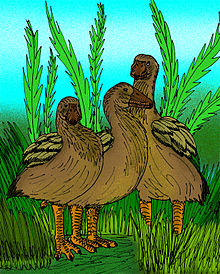Page version status
This is an accepted version of this page
| Oʻahu moa-nalo Temporal range: Holocene | |
|---|---|

| |
| Reconstruction of species’ appearance | |
| Scientific classification | |
| Domain: | Eukaryota |
| Kingdom: | Animalia |
| Phylum: | Chordata |
| Class: | Aves |
| Order: | Anseriformes |
| Family: | Anatidae |
| Genus: | †Thambetochen |
| Species: | †T. xanion |
| Binomial name | |
| †Thambetochen xanion Olson & James, 1991 | |
The Oʻahu moa-nalo (Thambetochen xanion) is one of two species of moa-nalo in the genus Thambetochen. Moa-nalo are a group of extinct, flightless, large goose-like ducks, which evolved in the Hawaiian Islands of the North Pacific Ocean.
Etymology
The specific epithet comes from the Greek xanion (“comb”), referring to the bony, tooth-like projections on the jaws.

Distribution
The species was described in 1991 from subfossil material collected by Storrs Olson, Helen James, Aki Sinoto and Eric Komori, from Barbers Point on the island of Oʻahu. Remains of the bird have also been recovered from Ulupau Head on the same island. It was smaller and less robust than its only congener, the Maui Nui large-billed moa-nalo.
References
- ^ Olson, Storrs L.; James, Helen F. (1991). "Descriptions of thirty-two new species of birds from the Hawaiian Islands: Part I. Non-Passeriformes" (PDF). Ornithological Monographs. 45 (45): 37–38. doi:10.2307/40166794. JSTOR 40166794.
| Taxon identifiers | |
|---|---|
| Thambetochen xanion | |
This prehistoric bird article is a stub. You can help Misplaced Pages by expanding it. |
This Anseriformes article is a stub. You can help Misplaced Pages by expanding it. |